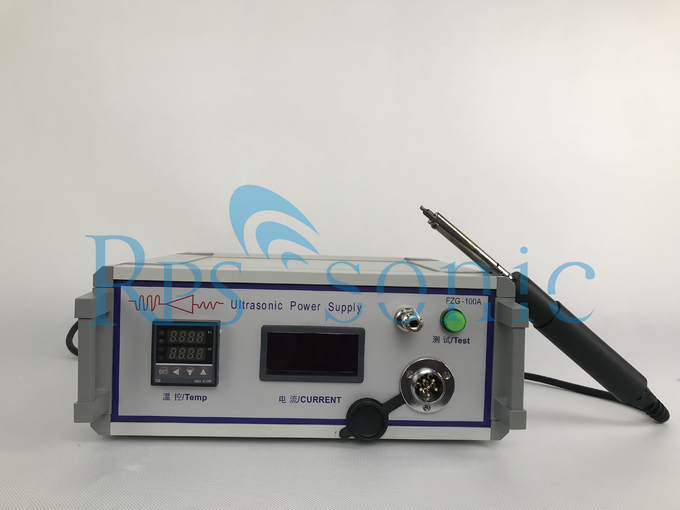60Khz 100w Portable Ultrasonic soldering iron equipment for Glass welding
Parameter
Description Ultrasonic soldering is a flux-free soldering method. Compared with traditional soldering methods, it is considered more environmentally friendly. Use vibration and cavitation to remove the surface oxide layer from the welding surface instead of chemical agents. Ultrasonic soldering technology is different from ultrasonic plastic welding, which uses vibration to generate heat to melt the connected parts. The principle of ultrasonic soldering is basically the same as that of ultrasonic cleaning. The vibration energy causes cavitation in the water bath or cleaning solvent. The surface of the part immersed in the liquid medium is cleaned by the strong erosion effect of cavitation bubbles. In the ultrasonic soldering process, heat from a separate energy source melts the solder before applying vibration energy. Then, the molten solder is used as an acoustic transmission medium for ultrasonic vibration. When high-frequency vibration energy is applied to the molten solder, it causes controlled acoustic cavitation at the tip of the soldering tool to destroy and disperse surface oxides. The cavitation microbubbles burst, clean all surfaces, wet the liquid solder and bond the pure metal. Vibration also ensures that there are no voids in the solder joints, and the vibration energy forces the liquid solder to penetrate into the gaps and pores of the substrate. It helps seal parts and increase the surface area to which solder can bond. Ultrasonic vibration can also squeeze bubbles out of liquid solder, so this method makes solder joints suitable for applications in high vacuum where sealing is required. Ultrasonic soldering allows the connection of different materials and can be used for materials that are difficult to solder by conventional methods. Since no flux is required, users can save the time and cost of cleaning flux residues, while reducing corrosion and improving the durability of solder joints. The ultrasonic soldering method can be conveniently used for manual welding with the help of a handheld ultrasonic electric soldering iron equipment, or it can be grafted to an ultrasonic welding machine and assembly line for use. Glass, ceramic, stainless steel, aluminum welding In years of extensive research on glass-metal bonding, Japanese engineers have developed a special solder alloy called CERASOLZER (solder wire). This active solder alloy is specially formulated for the ultrasonic welding method and has a very unique bonding ability, which can replace the commonly used silver baking, indium brazing, molybdenum manganese and resin bonding methods. CERASOLZER chemical bond (glass substrate) In addition to the direct metal-to-metal bond, Cerasolzer can also form a strong chemical bond with the welded substrate. The alloy is composed of the same main components like a standard solder alloy (lead/tin), but in addition it also contains a small amount of elements such as zinc, titanium, silicon, aluminum, beryllium, rare earths, etc. These elements have the same effect as oxygen. Very strong chemical affinity. During the welding process, these additional elements combine with the surrounding oxygen to form an oxide, which is chemically combined with various materials, including glass, ceramics, aluminum, stainless steel, conductive oxides, and many other previously used oxides. Other substrates that are considered non-weldable. The resulting oxide is combined with the solder substrate, forming a very strong chemical bond (RO) at the interface. Therefore, if oxygen is effectively eliminated by replacing the air around the bonding equipment with an inert gas (such as nitrogen), the adhesion of the Cerasolzer will be lost. The results show that the appropriate critical oxygen concentration for bonding is about 2%. The melting temperature of Cerasolzer alloy is between 155 and 297℃. Due to ultrasonic vibration, the welding method is flux-free. In fact, if our ultrasonic welding method uses flux, it will destroy the oxygen bond and destroy the entire welding process, so it should not be used. Application Glass jewelry manufacturing Optical glasses coating/metallization Making electrodes on glass and ceramic plates Welding of heating contacts on the rear window of a car Welding superconductors, components, ceramic accessories Vacuum sealing of glass tube, bonding of hardware accessories Sealing of optical glass fiber (metal ferrule bonding) The electrode is bonded to the front/back contact of the solar cell (crystalline, thin film) Bonding leads (dots) in metallic glass, liquid crystal glass, crystal oscillator, hybrid integrated circuit 
| model No. | RPS-SI60 |
| Ultrasonic frequency | 60Khz |
| Power | 100w |
| Temperature Range | 150 ~ 400 °C |
| Power Supply | 220V / 50-60 Hz |
| Generator Feature | Ultrasonic Amplitude Adjustable |
| Iron Handle Length & Diameter | 190mm / Ø20 |
| Avail Soldering Matrial | ITO Glass, AL, Mo, Cu etc., |
